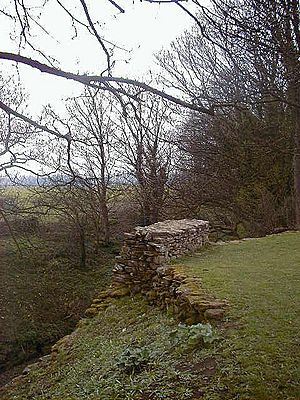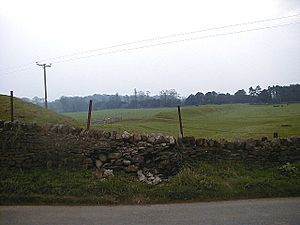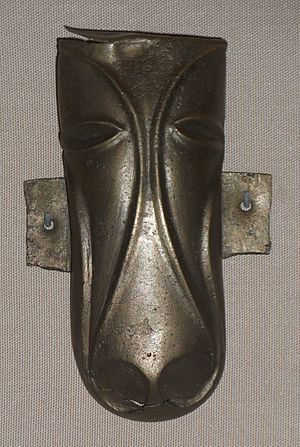Stanwick Iron Age Fortifications facts for kids
The Stanwick Iron Age Fortifications (also called 'Stanwick Camp') are a massive ancient fort from the Iron Age. They are found in Richmondshire, North Yorkshire, England. This huge site has over 9 kilometers (5.6 miles) of ditches and walls. These walls enclose about 300 hectares (740 acres) of land.
Stanwick was a very important place for the Brigantes, a powerful tribe in ancient Britain. This was especially true when the Romans first arrived. It is now a protected historical site.
Contents
Where is Stanwick and what does its name mean?
The Stanwick fortifications are located about 8 miles (13 km) north of Richmond. They are also 10 miles (16 km) southwest of Darlington. The site is close to Scotch Corner.
The walls of the fort are almost 5 meters (16 feet) high in some places. They completely surround the small village of Stanwick St John. This makes Stanwick one of the largest Iron Age settlements in Britain. The name 'Stanwick' might come from an old Norse word meaning 'stone walls'. Another idea is that it comes from an old Anglo-Saxon word meaning 'stone settlement'.
The Stanwick Hoard
In 1845, a collection of 140 metal objects was found near Stanwick. This collection is known as the Stanwick Hoard. It included four sets of horse harness parts for chariots. There was also a bronze horse head that might have been part of a bucket.
These amazing items are now kept at the British Museum. The museum also has the Meyrick Helmet. This helmet might have been part of the hoard, or it could have been made at Stanwick.
Mortimer Wheeler's Digs
Sir Mortimer Wheeler was a famous archaeologist. Stanwick was the last major place he dug in Britain. He worked there during the summers of 1951 and 1952.
Wheeler believed the huge site was built in three main stages.
- Stage 1: Around 40 AD, a smaller earthwork was built on a low hill. This area was about 17 acres (6.9 hectares).
- Stage 2: Around 50–60 AD, a new area was added to the north. This made the fort much bigger, covering over 130 acres (53 hectares).
- Stage 3: Finally, around 72 AD, the fort was made even larger. Another 600 acres (240 hectares) were added to the south.
During his digs, Wheeler cleared a 50-foot (15 m) section of a ditch. The Brigantes tribe had cut this ditch from the rock. He also rebuilt a 10-foot (3 m) section of a stone wall. This wall was made from stones found in the ditch. It is known as 'Wheeler's Wall'. This section is still protected today. It helps visitors imagine how impressive the fort looked long ago.
Among Wheeler's most exciting discoveries was an Iron Age sword. It was still in its wooden scabbard, which was very rare. Nearby, he found a human skull with damage from an axe or sword. These were found near the main northwest gate. Wheeler thought they might have been hung on the gate as a warning to enemies.
Wheeler believed Stanwick was the base for Venutius. Venutius was the husband of Queen Cartimandua, who ruled the Brigantes. Their relationship ended, and Cartimandua chose to support the Romans. Wheeler thought Venutius gathered his anti-Roman fighters at Stanwick. He believed this was where Venutius planned his revolt against the Roman invaders.
Durham University's Digs
More important archaeological digs at Stanwick happened from 1981 to 1986. A team from Durham University led by Percival Turnbull and Professor Colin Haselgrove carried out this work.
One of their most mysterious finds was the burial of an adult man. A horse's head had been carefully placed on his body. Turnbull and Haselgrove thought that the huge outer walls of Stanwick were built first. This was probably in the mid-first century AD. Then, the inner areas were divided up.
They also believed that the fort's enormous size was not just for defense. They thought it was meant to show how powerful, important, and rich its owner was. They concluded that Stanwick was not the fort of Venutius. Instead, they thought it was the estate of his former wife, Queen Cartimandua. It might even have been the original main city of the Brigantes tribe.
See also
 In Spanish: Stanwick (Yorkshire del Norte) para niños
In Spanish: Stanwick (Yorkshire del Norte) para niños




